The weekend of Saturday 13th and Sunday 14th February 1999 saw the first official outing of the Composite Battalion in this country.
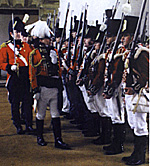 The First Battalion being inspected at Bolsover Castle.
The First Battalion being inspected at Bolsover Castle.
Despite an arctic wind blowing in off the Derbyshire Hills, the two-day event held at a bleak Bolsover Castle witnessed various re- enactment societies joining together to practice drill as one unit. The weather and site was in sharp contrast to the origins of the Battalion.
In the summer of 1998, many U.K. societies portraying a variety of British Army Georgian Regiments, dating from 1793 to 1815, were invited to a festival in Malta. The event commemorated the French seizure of the Island and its subsequent liberation by British forces.
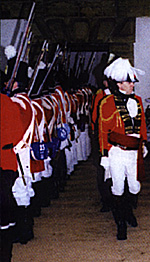 David Banks inspecting the First Battalion at Bolsover Castle.
David Banks inspecting the First Battalion at Bolsover Castle.
To co-ordinate the British reenactment societies who had journeyed to this sunny clime more effectively, a Composite Battalion was formed consisting of all participating Redcoats. The result was a qualified success. Under the auspices of Serjeant Jeff Peacock of the 68th Durham Light Infantry, the Composite Battalion was drilled into shape until it could perform the appropriate drill and manoeuvres of the period as a team.
Upon returning to damp rainswept Britain, the idea of forming the Composite Battalion on a more permanent footing gained acceptance from those who had originally experienced the initial concept and from other similar interested societies. By November 1998, enough interest had been expressed so as to call a meeting, which proposed to establish the Composite Battalion and to create the ground rules for its future operation. Many of the Redcoat societies sent along representatives to this meeting, including the large independant northern groups.
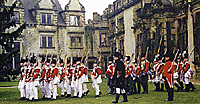 Part of the First Battalion drilling at Bolsover Castle.
Part of the First Battalion drilling at Bolsover Castle.
Large Drilling Photo (slow: 117K)
Held in a cordial and productive manner, the meeting agreed to a series of initiatives. A code of conduct was drawn up by which the Composite Battalion was to be run. A Battalion structure was also agreed upon; the different societies forming the Battalion would, according to their size, either form their own independant company if they have a large enough membership, or smaller sized societies would be grouped together to form other companies. Each company would have a Commander, either an Officer or Senior N.C.O. who would take ultimate responsibility for that unit. The new formation would be termed the First Composite Battalion.
 Richard Moon and David Banks, Senior Officers of the First Battalion.
Richard Moon and David Banks, Senior Officers of the First Battalion.
In overall command of the Battalion would be two Senior Officers, one acting as a more informal figure head and the other as the Commander at displays. These two Senior Officers serve only with the consent of the Officers belonging to the individual societies comprising the Battalion. To aid the Senior Officers in their endeavours, these Officers have appointed a small battalion staff who will run on military lines the Battalion following as closely the original historical staff role. This may simply take the form of carrying orders from the Senior Officers to the Company C.O.'s. or informing the Composite Battalions Company's where they are to assemble during each day's events etc. As they are not elected however, Staff Officers will have no authority within any unit.
Along with forming the Battalion's structure, the November meeting debated the need for one standard type of drill to be practiced. Whilst some societies were already conversant with Dundas's 18 Manoeuvres and the Manual of Arms; the Battalions objective was to train all its constituent members up to a high standard of Drill so as to move and act as one body.
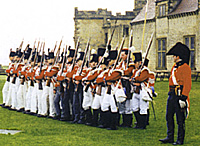 The First Battalion drilling at Bolsover Castle.
The First Battalion drilling at Bolsover Castle.
Despite the agreement of a standard of drill, a practical acceptance had to be made regarding uniforms. All society representatives agreed that uniform clothing was to be as authentic as possible, though it was acknowledged that variations in uniforms would exist making a uniformity of appearence unachievable. This was due to the Battalion consisting of various societies each one portraying a different period of the British Army during the Revolutionary and Napoleonic Wars. A variation in uniforms would thus exist to reflect the changes that took place in style between 1793 and 1815 besides differences in uniforms caused by Regimental distinctions.
 The First Battalion being inspected in the 17th Century Riding School of Bolsover Castle.
The First Battalion being inspected in the 17th Century Riding School of Bolsover Castle.
However, it was hoped that the overall impression of a large body of men, acting as a team, would to some extent compensate for this. After all, the Duke of Wellington himself was unconcerned with his men's appearance provided they had 60 rounds of ammunition and their muskets worked.
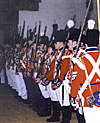 Part of the First Battalion being inspected at Bolsover Castle.
Part of the First Battalion being inspected at Bolsover Castle.
So, on a cold grey day in February, between 50 and 60 Redcoats marched up and down Bolsover Castle green clutching with fumbling, frozen fingers metallic musket barrels and then warm mugs of tea (Heaven!). The societies who endured this first drill included the 23rd, 33rd, 45th, 68th and 95th. Other societies contributing to the First Battalion include the 16th, 37th, and 47th Foot, plus the 12th Light Dragoons, with quite alot of other groups interested. Overall, the weekend was deemed a success, for as dusk set on Sunday, the Redcoats present were seen to be moving and acting as one. It is early days yet, but it will be interesting to see how the First Battalion develops.
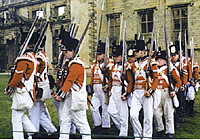 The First Battalion drilling at Bolsover Castle.
The First Battalion drilling at Bolsover Castle.
As a final note concerning the Battalion impetus to its formation has been stimulated by news from across the Channel in Europe. Over there, a European Napoleonic Society has been developing with its members formed along the lines of Army groups. Thus, there are French, Austrian, Prussian, etc, Army groups; And no matter what nationality you or your society are, if for instance you are English portraying French, you join the French Army Group and not any National (eg. English) group of like minded societies but different national impressions.
Following a meeting in London on the 21st February which involved representatives of all the U.K. groups who took part in the Malta event, together with the Sp for all those interested in high quality British Army re-enactment of the late 18th and early 19th centuries.
Back to Table of Contents -- Age of Napoleon #31
Back to Age of Napoleon List of Issues
Back to MagWeb Master Magazine List
© Copyright 1999 by Partizan Press.
This article appears in MagWeb (Magazine Web) on the Internet World Wide Web. Other military history articles and gaming articles are available at http://www.magweb.com